In 1978, the Wieliczka salt mine was the first of its kind to be recognized by UNESCO and placed on the list of World Heritage Sites. Five decades later, in 2013, the Bochnia mine was added to the list as well. From the 13th to the 18th centuries, these two mines operated as a single establishment. It was run by a salt collector appointed by the king. The commodity was exported abroad, to Hungary and Ruthenia, as well as to other countries. At its peak, in the early 17th century, Wieliczka mine employed approximately two thousand miners.

The story of the mine can be traced back to the legend of St. Kinga. The Hungarian princess, who married Boleslaw the Chaste, did not accept any wealth or servants as her dowry. Instead, she requested salt. Her father gave her the Marmarosz mine in Transylvania. She brought along some experienced miners to Poland, and when they started to excavate tunnels in the vicinity of Krakow. That is how it all started.
Currently, the Wieliczka mine has nine levels, ranging from 64 meters to 327 meters in depth. It has numerous tunnels that together measure 360 kilometers. There are tourist paths with attractions such as the St. Kinga Chapel, the world’s largest underground temple, located 101 meters beneath the surface. The Bochnia mine also has nine levels, 60 kilometers of tunnels from 70 to 289 meters deep, plus three ancient shafts from the 13th, 16th and early 20th centuries.
Exploring the old mines gives you an insight into the life of miners. There is also a unique climate that can be beneficial for your health. There are even programs available to encourage health rehabilitation through underground visits.
↳ Make sure to read my guide to the most amazing places to stay in Kraków:
How to Find Best Place to Stay in Krakow Old Town – Your Guide
By the way, you may also be interested in reading my article about other UNESCO SITES in Poland: Exploring Poland’s Cultural Riches: A Guide to UNESCO Cities
How Come There Is Salt in Wieliczka?
It is believed that the salt deposits in this area have been around since the beginning of time. Legends say that when the mythical fire-breathing dragons roamed the earth, these deposits already existed. Research indicates that the **Wieliczka deposit originated 14 million years ago, during the Miocene era, when the Paratethys Sea (also known as the Sarmatian Sea) began to recede.
This sea was heavily salinated and stretched from our land to Central Asia. The high temperatures caused the water to evaporate and the salt to settle at the bottom of the sea. As the Carpathian Mountains were being formed around the same time, the bottom of the basin was lowered significantly, which greatly boosted sedimentation.
It’s quite remarkable that in the southern part of the sea there was a solid nugget deposit, while in the northern and central part a bed deposit was formed. After the Carpathian Mountains’ recent movement, the nugget deposit overlapped the bed deposit.
As a result, the Wieliczka salt deposit is currently about 10 kilometers in length and varies from 600 meters to 1500 meters in width, and from a few to roughly 400 meters in depth. Such a massive salt deposit has certainly enabled the Vistula River region to enjoy a prosperous life for many centuries.
Salt Mine „Wieliczka” Today
For some time, the mine balanced its conventional mining operations by accepting more and more visitors. In 1996, the industrial production of salt was stopped. This does not mean the salt was wholly taken out from the Wieliczka deposit. At present, brine is drawn from here, which is then turned into salt through the brewing process. It is utilized, among other things, to make cosmetics.
If you’re about to decide on a 3.5 km-long hike, be aware that you’ll be trekking down almost 800 stairs, taking you 135 meters closer to the Earth’s core. It is truly remarkable that the mine used to burrow down to an incredible 327 meters! Throughout its history, nine levels were mined, but only three are now open to the public. And here’s the most incredible part – you only see 2% of the total underground!
This is because there are 245 km of tunnels, alleys and more than 2,000 chambers in the mine. Unfortunately, the least valuable sections are now being backfilled and preserved. If you take a guided tour, the deepest you can reach is 135 meters.
- Wieliczka Pictures and Google Map Location : Click Here
Which Route To Choose?
When planning a trip to the Wieliczka underground, you will be able to choose one of several routes. The most popular is the Tourist Route, which I recently traversed myself. **Schedule around four hours for the entire trip and related activities, as the Brine Graduation Tower awaits you above. ** During peak season, it is advised to book tickets in advance. It would be easiest to do online. All tours are guided.
My advice for you? Put on comfy shoes and something with long sleeves, because due to the ventilation system, wind can sometimes blow inside the mine. The temperature underground is around 17-18 degrees Celsius. It is also advisable to confirm the current tour hours before you go, as they are subject to change.
The Tourist Route is a 3.5 km journey that showcases the most breathtaking views of the mine. As you journey through the captivating chambers and salt chambers, you will be accompanied by a guide. An excursion takes up to 3 hours and can include a maximum of 30 people.
The tour is available from 8 am to 6 pm, and a ticket includes admission to the Tourist Route and the Cracow Saltworks Museum (an extra 40 minutes). All ages are welcome to explore this exciting experience.
The Legends Trail Tour is ideal for children. As they travel through the salt underground with the guide’s captivating stories, young explorers will be introduced to the heroic characters of the Wieliczka legends. The tour is conducted along the Tourist Route.
- If you find yourself in St. Kinga Park, you should stop by the Salt Graduation Tower. It’s located right by the Danilowicz Shaft and close to the Grand Sal Hotel. It’s open from 10:00 in the morning until 6:00 in the evening. If you take the time to walk around the tower, it should take about half an hour. You can enter the tower on an individual basis.
- On the Mining Route, visitors can become experts in the underground trade, explore the many twists and turns of the salt mine. Adventurers will face a variety of tasks, such as navigating the mine and doing practical mining work. The route is dimly lit, but you will be equipped with a lamp, transmitter and canister to make you feel like a true miner. Unfortunately, due to the pandemic, the Mining Route sometimes is closed, so double check before arrival.
Tourist Route in the Wieliczka Salt Mine – My Experience
I was aware of the mine being massive, but I never imagined it would be such a complicated labyrinth of tunnels. Some people joke that it is an enormous underground Swiss cheese. The Tourist Route accounts for only 2% of Wieliczka’s total underground area.
It’s hard to comprehend the magnitude of the tunnels and the countless chambers beneath our everyday world. The Tourist Route through Wieliczka Salt Mine takes you through the most extraordinary parts in terms of nature, geology and culture. You will explore more than 20 chambers, walk 3.5 km of corridors and ascend nearly 800 stairs.
You will explore the history of the salt and be able to witness beautiful re-enactments and methane explosions. To make the experience even more special, your guide will share interesting stories and anecdotes as you descend into the 64-135 meter deep mine.
The tour begins by descending the stairs to 64 meters, then you will explore the three levels of the mine. I highly recommend that you join the first group of the day. This way you can experience the tour with no one ahead of you.
We started the tour by going down into the ground via the Danilovich Shaft, which was completed in 1640. Unfortunately, this shaft is currently undergoing renovation, so we had to access the depths of the mine using the Paderewski Shaft, going down lots of stairs. In the past, this was the route for ore extraction, but now it is mainly for tourist use. The same route was also used to get the horses down into the mine.
The Anthony Chapel is only available to those on the Pilgrimage Route, so regular tourists won’t be able to discover it. But, it is situated next to an area with a lot of moisture in the air. This has caused the sculptures to be eroded, and sadly, they have become unrecognizable from what they used to be. It is now hard to figure out what they presented in the past.
Janowice Chamber
It is widely known that the patron of salt miners is Saint Kinga, a woman of the Arpad dynasty who was married to Boleslaw the Chaste. Here in the Janowice chamber, you will get to hear an alternative story of where the salt in Wieliczka originated.
It won’t be any boring geological facts, but rather a multimedia display narrating the tale of discovering St. Kinga’s wedding ring. Since 1967, the chamber has featured five statues made of salt, crafted by the miner-sculptor Mieczyslaw Kluzek. You can find this chamber situated on the initial level of the Wieliczka mine, about 64 meters beneath the surface.
St. Kinga’s Chapel – The Symbol of the Wieliczka Mine
St. Kinga’s Chapel, situated between 91.6-101.4 meters deep in the Wieliczka mine, is definitely the most beautiful place in the mine. Visitors have the privilege of seeing the chapel from a terrace, before descending, to witness the remarkable craftsmanship and attention to detail of the chapel.
The chapel is completely carved out of salt, featuring a salt block floor, incredible sculptures, bas-reliefs and even crystal chandeliers made from the purest form of salt. Each and every detail of the chapel is sure to make visitors marvel in awe.
The sheer size of the largest chandelier in St. Kinga’s Chapel, which contains 2,500 crystals, is truly remarkable. The chapel was built in 1896, once a massive block of green salt was mined. The sculptors of the artworks are Jozef and Tomasz Markowski, Antoni Wyrodek and the trio of Stanislaw Angel, Piotr Starowicz and Pawel Janowski, the makers of the statue of John Paul II, which was made in appreciation of the canonization of the chapel’s patron saint.
This underground church is the biggest in Europe, with dimensions of 12 meters in height, 18 meters in width and 54 meters in length. Inside the altar area we will see the relics of St. Kinga and John Paul II.
Read more about this underground church in Poland in this article: World’s Largest Salt Mine Church -A Must-See Wonder in Poland
Balloon Flight in the Chamber of Stanislaw Staszic
During the 19th century, miners extracted a tall and thick block of salt. It has formed a 36-meter-deep chamber. It was named after Stanislaw Staszic, the pioneer of geological studies in Poland.
The chamber is a testament to the seemingly limitless power of human imagination. In 2000, the record was set for the deepest underground hot air balloon flight. This required two years of preparation, which included modifications to the 14-meter-diameter, 18-meter-high balloon. During the flight, the balloon was able to soar up to 213 centimeters in the air and remain there for four minutes.
The Staszic Chamber was also used for bungee jumping. On the occasion of the 30th anniversary of the Wieliczka Salt Mine being listed as a UNESCO World Heritage Site, a bas-relief depicting all 12 sites was made in the chamber.
The Wieliczka Salt Mine Graduation and Observation Towers
Visiting the Wieliczka Salt Mine wouldn’t be complete without seeing the large brine graduation tower in St. Kinga Park near the Danilowicz Shaft. It has a unique medieval castle design with a spacious yard. You can even climb up the ramparts and get an incredible view from the 22.5-meter-high observation tower To access the area, you’ll need to purchase a ticket. It’s possible to get a discounted rate if you buy a package ticket that also includes entrance to the mine.
How Does The Graduation Tower Operate?
Essentially, the brine from the mine seeps out of the top of the 3200 m2 dam. As it falls, it hits the blackthorn branches and breaks into microparticles, creating a distinct mist that envelops the area. This aerosol, similar to what you’d find near the ocean, is then inhaled by visitors. The atmosphere during your visit will determine the amount of aerosol in the air. On sunny days, when the wind is blowing between the branches, the air will be more saturated with brine. On the other hand, when the humidity is high and it’s raining, there is almost no aerosol in the air.
Where To Stay Overnight in Wieliczka To Be Close to The Salt Mine?
If you’re planning a trip to the Wieliczka Salt Mine, I can suggest the grand Grand Sal Hotel, which is located conveniently near the Danilovich Shaft. Whether you’re looking for a romantic getaway or a family time, this hotel is an excellent option and it’s a quick 35-second walk from the ticket offices. As an added bonus, from the hotel, you can get a glimpse of the Danilowicz Shaft, Padewski Shaft, and the Brine Graduation Tower.
The Wieliczka Salt Mine Spa
It is noteworthy to mention the positive aspects of a longer stay in the Wieliczka salt mine. You can stay at the mine for a period of time longer than the duration of the tour. This is possible thanks to the fact that an underground spa has been in operation there since 2011.
At a depth of 135 meters, visitors can enjoy the health benefits of the beneficial microclimate of the salt chambers. The most frequent visitors are people suffering from respiratory diseases and allergies. The air is characterized by excellent bacteriological cleanliness and the absence of allergens and pollutants, which leads to excellent results for this type of treatment.
Dr. Feliks Boczkowski was the first to start researching the benefits of microclimates. He noticed that the miners in Wieliczka suffered much less from respiratory diseases than the miners in the coal mines. Thanks to the efforts of the doctor, a spa was established in Wieliczka in 1838. He was a proponent of inhalations, salt baths, and brine treatments.
Bibliography
- https://en.wikipedia.org/wiki/Wieliczka_Salt_Mine
- https://www.wieliczka-saltmine.com/
- https://krakow.wiki/wieliczka-salt-mine/



